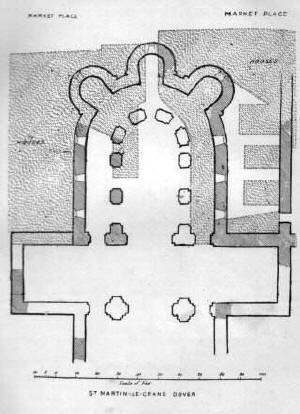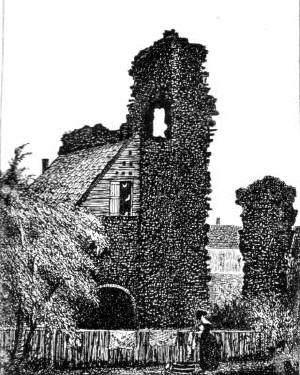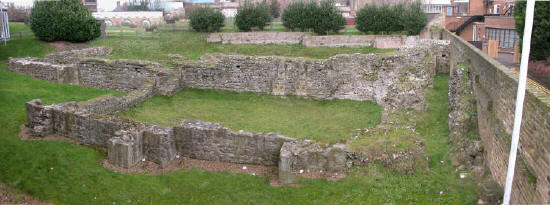|
The church of St Martin le Grand stood on land between
the current Market Square and York Street. It has been a ruin for
centuries. All that currently remains is a small section of the
walls adjacent to the Public Library and the Roman Painted House.
The modern-day buildings in the Market Square are to the right of the
picture. |
|
|
|
|
A century after the Roman invasion,
when the inland harbour was becoming silted up and land around the present
Market Square was being reclaimed from the sea, King Withred of Kent took
possession of the area to build a church and monastery for the Canons who
were at that time living in the castle. The building work was carried
out between 691 and 726 on the western side of the square, alongside the
river. When the Normans set fire to Dover in 1066, much of the Saxon
church and monastery was destroyed. However, being a religious people,
they re-built the church in Norman style and restored the Canons.
However, the Norman Archbishops were not happy about the Saxon Canons of St
Martin being outside their control and Archbishop Corboil induced King Henry
I to set them adrift and established the Priory, a religious house under
stricter monastic rule.
For the next 440 years, up to the reign of Henry VIII, the precincts were
used as a market place. |
|
 |
This ground plan of the church of St
Martin-le-Grand is taken from a drawing made in about 1845 by the Rev. F. C.
Plumptre.
"It will be seen ... that the church consisted of a nave of unknown
extent, which occupied a considerable part of the open land at the rear,
which, after the destruction of the church, was used as a burial ground
for St. Mary's parish; a transept, 25ft. in depth, over which there was
doubtless a central tower; and, beyond this, extending about 80ft. towards
the Market place, was the apsidal choir, ending flush with the present
frontages. The choir had three projecting apsidal chapels, one in
the centre, and the others respectively facing the north-east and
south-east." (J.B.J. 1907)
|
|
This sketch, drawn some time in the early 19th
century, shows the largest fragment of what was left of the ruins at that
time. Notice the lady in the foreground, apparently hanging out
washing on the fence. The writing on the two items to her left reads
"ST MARTIN'S" and "CHURCH". It looks almost as if the left-hand
portion of the ruin might have been lived in. |
 |
|
"The walls were lined with Caen stone, a building material which
came much into vogue immediately after the Conquest. Possibly, the
nave of the church survived the fire of 1066, and the Saxon work being old
and inferior to that of the Normans, would account for that part of the
fabric having totally disappeared. The ground plan only shows the
design and arrangement of the transepts and the choir, and a very small
portion of the north wall of the nave. The faint parts of the plan
represent the portions of the foundations where there was not one stone
upon another, but the outline has been continued to complete the design.
A curved wall of considerable height, usually called a tower, was the
southern part of the central apsidal chapel of the choir, and the remains,
showing the spring of the vaulting, indicate that it consisted of two
stories. he narrow 4ft. space, showing white, through the middle of
the central apsidal chapel into the interior of the ruins, was made - and
specially mentioned in a deed - in the time of Queen Elizabeth, and was
then used as a passage for the funerals to pass up when the land in the
rear was used as a burial ground. That passage has disappeared.
A projecting mass of masonry of a similar shape to the piece of the
central chapel used to be seen, covered with a sloping modern roof on the
southern side, as shown in the old print, and a similar fragment stood
above the houses on the north side. These were parts of the
north-east and south-east apsidal chapels. There used to be a small
portion of the outer wall of the north transept seen from Market Street.
Three of the interior arches of the north side of the choir were standing
in 1840, with the triforium and a small part of the clerestory over it.
A large portion of the piers of the arch which was supposed to have
supported the central tower was also standing at that time. The
piers were solid blocks of flint rubble, with Caen stone dressings, about
eight feet wide by six feet deep. All the arches were semi-circular,
relieved by only one order, which was carried down the side of the piers.
The remains of this ancient church are interesting as being a rare example
of the three projecting chapels at the east end of the choir being left
unaltered. It also illustrates the discovery made by the late Canon
Scott Robertson that the three parishes of St. Martin, St. Nicholas, and
St. John the Baptist had their churches under one roof - the
southern chapel containing the altar of the church of St. Nicholas, the
central one that of St. Martin, and the northern one that of St. John."
(J.B.J. 1907)
|
|
In 1159, when the Monastery was
removed to Dover Priory, St. Martin-le-Grand lost its ancient privileges as
a Royal chapel and became the Parish Church of Dover until its desecration
soon after 1528. The church was partially restored during the
parochial period but, immediately after the Reformation, it seems to have
rapidly fallen into decay and the extensive precincts, bounded by King
Street, Queen Street, Princes Street, Market Street and the Market Square,
passed into private hands. |


